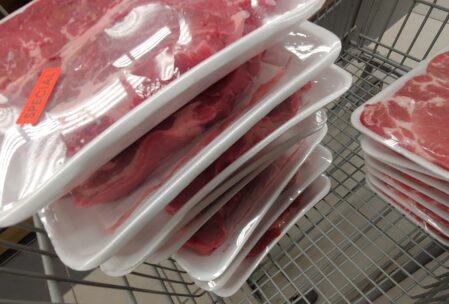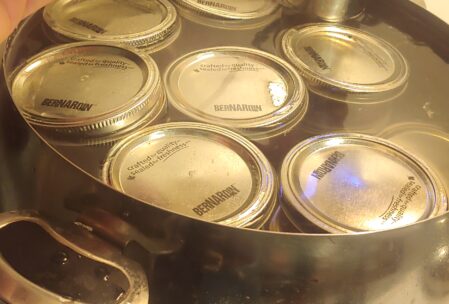Sous vide meat
Use palette de boeuf (shoulder blade?). It’s an inexpensive, tasty piece of meat that is usually disregarded as a “though cut”. Ideally buy the meat without bones, as the bones can be tricky to remove, and won’t fit inside the jars. We will tenderize this to perfection and turn it into gold while keeping it medium-rare.


Remove the bones and large pieces of fat and conductive tissue. It’s ok (and recommended) to leave smaller pieces of fat. That fat will render, become super tender, and provide taste. Try to keep the larger pieces of meat intact for better presentation (it’s nicer to plate a big piece than smaller ones).
Optional: sear the beef at very high temperature to add colour, flavour, and eliminate surface bacteria. To reach this high temperature you need gear that can reach high temperatures (ex: cast iron, wok – avoid Teflon as it is unsuitable for high temperatures). If you have a grill or a cast iron with a grill texture, this will add these visually pleasing grill lines.

Cut in chunks just large enough to fit a mason jar. You might need to put a bit of force to get the meat in. Leave a bit of empty space, specially if you plan to freeze the meat (else the jars will break in the freezer as water expands). However, if you leave too much air, the jars will float and make them harder to manage.
Don’t close the lids too tight, as the jars will need to release some air when they will be immersed into the hot water.
Take in account that the jars need to be fully immersed with water. Since some water will evaporate over time, you will need to refill from time to time. If you don’t have enough water covering the jars, you might be too tight between refills.
Sous vide at 55.5C for 36h. Shorter cooking times will provide more “bite” to the texture. Longer cooking times will give a softer meat (beware, as “too soft” can feel like a “paté-like” texture).

As you remove the jars from the hot water, you want them to get cold as quick as possible (to minimize the time meat spends at temperatures where bacteria multiplies – roughly 5C to 50C) while avoiding rough temperature changes (which can crack the jars). I recommend putting the pot with the jars under cold water from the tap, so that the hot water is gradually replaced by cold water.
After the jars are less hot, you can add ice to the water. To accelerate the process you can set the sous vide device to 0C so that it circulates the iced water.

If the jars are properly sealed, they can keep up for weeks in the fridge – as the contents of the jar will be pasteurized (very low bacteria count) and no new bacteria will be able to get in.
When you are ready to eat, you just need to “sear” the already cooked meat.
- Remove the meat from the jar, and try to keep most of the liquids in the jar
- Pat dry the meat.
- Add seasoning (ex: salt and pepper) and sear on an extremely hot cast iron. You want the meat to get slightly charred on the outside, as fast as possible, so that the (already perfectly cooked) inside over-cooks as little as possible.
- Optional mayo-hack: A think layer of mayonnaise will help keeping salt/pepper in place, while the protein/oil mix helps to create a nice caramelized texture. The final product will NOT taste like mayonnaise.
- Optional butter finishing: smear a subtle layer of butter before serving. It will melt and add a nice glossing finishing, while improving the flavour
Pan sauce
When you are done with the meat, while keeping the fire very high, throw some liquid into the pan to clean the small slightly burnt bits (use the remaining liquids from the jar!! you can also use some tasty liquid like wine, broth, rum, etc… else, water is ok).
Scrub the bottom clean with a wooden flat spatula while the liquid boils. When the liquid is almost reduced (to a spoon or two) add a couple of spoons of butter and mix quickly with the spatula. The quick boil of the liquid will emulsify the liquid with the fat to create a creamy texture. Add salt and pepper.
If the sauce looks watery, let it boil some more. If it looks greasy and separated (instead of creamy) add a spoonful or two of water. The pan needs to be very hot to get a vigorous boil that will help the emulsification of the sauce.
Categories: Uncategorized
Leave a Reply